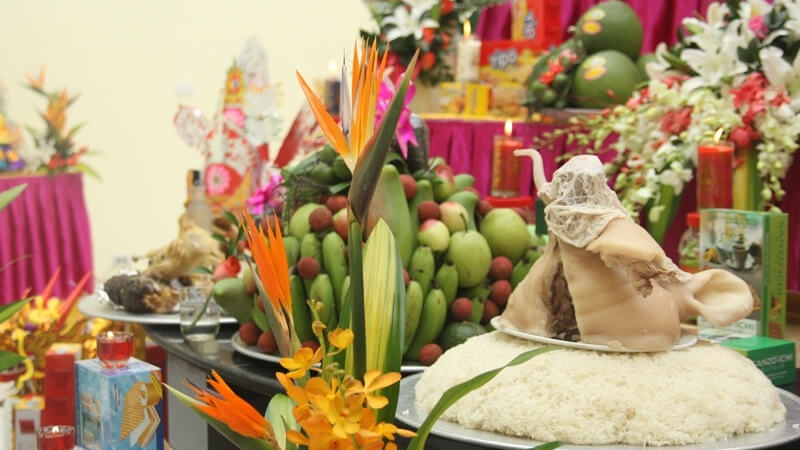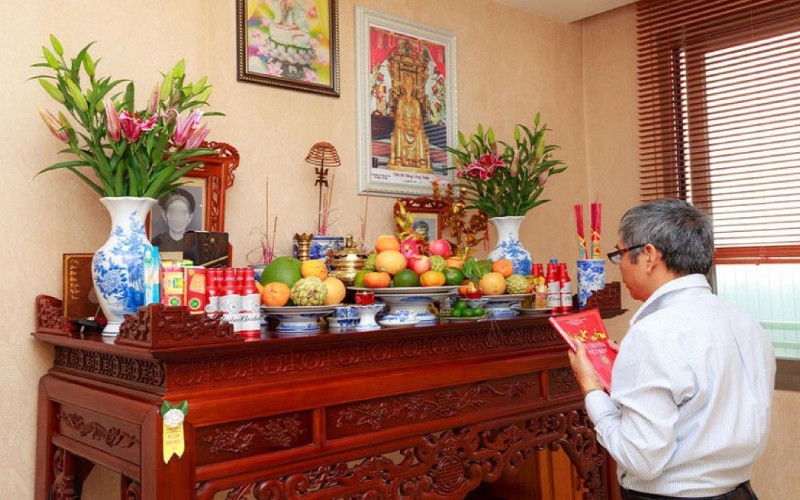Moving into a new home is a significant step for any family in Vietnam. This time-honored tradition is deeply rooted in the culture and is believed to express gratitude to ancestors and seek happiness for the entire household. We will reveal the rituals and meanings behind moving into a new home in this article.
1 The Significance of Housewarming Rituals
 The Significance of Housewarming Rituals
The Significance of Housewarming Rituals
Housewarming rituals, passed down through generations, hold great importance in Vietnamese families. The primary purpose is to inform the gods and ancestors of the new house, particularly the god of land and the family’s ancestors.
The family often prepares a feast to treat their relatives, using the meal as a means to inform their ancestors of the new house and seek their blessings and financial prosperity. Therefore, the timing of the move is carefully chosen.
2 Preparing the Offerings for the Housewarming Rituals
Selecting an Auspicious Day for the Rituals
To ensure a smooth transition, choosing an auspicious day is essential. An ideal day should meet several criteria, including being favorable for the homeowner, a harmonious day between heaven and earth, and compatible with the homeowner’s age.
What Should Be Included in the Housewarming Offerings?
 Preparing the Offerings for the Housewarming Rituals
Preparing the Offerings for the Housewarming Rituals
The first essential item is the fruit tray, which should include at least five different types of fruits arranged according to feng shui principles. The number of fruits should be odd, and they must be large, beautiful, and undamaged.
The incense, candles, flowers, betel, and areca nuts are also indispensable in any Vietnamese worship ritual. For the housewarming ceremony, the incense and flower arrangement typically include: one bundle of incense, a pair of candles, a bouquet of fresh flowers, three betel leaves and areca nuts, paper offerings, and three jars of water.
The homeowner decides whether to offer vegetarian or non-vegetarian dishes, but this is not a critical aspect.
For a non-vegetarian meal, you can prepare: a dish of sticky rice, a whole boiled chicken, a set of three cooked dishes (a piece of boiled meat, a boiled shrimp, and a boiled fish), three cups of tea and three cups of wine, some stir-fried dishes, and a soup. If you prefer a vegetarian option, you can prepare four to five dishes, such as vegetarian spring rolls, vegetarian “chicken,” stir-fried vegetables, and soup.
3 Performing the Housewarming Rituals
The housewarming rituals can be conducted as follows. You may skip any steps that are not suitable for your family or customs.
-
Start by lighting a charcoal stove and placing it at the entrance. You can do this before the moving truck arrives to save time.
-
When the moving truck arrives, arrange the offerings neatly on a tray and get ready to perform the rituals.
-
The head of the household, preferably the male breadwinner, should be the first to step over the charcoal stove and enter the house, carrying the ancestral tablet and incense burner.
-
The remaining family members then follow suit, each carrying items for worship. Remember to bring along lucky charms such as mats, mattresses, and stoves. Do not enter the house empty-handed.
-
The first thing to do upon entering the house is to turn on all the lights and open the main door and windows to let in fresh air and positive energy.
-
While some family members arrange the altars for the ancestors and the god of land neatly, the others set up the offering tray in the middle of the house, facing the lucky direction according to the homeowner’s age.
 Performing the Housewarming Rituals
Performing the Housewarming Rituals
-
The family representative lights the incense and recites the prayer. The other family members stand in front of the offering tray with their hands clasped together in a respectful manner.
-
After the prayer is finished, while the incense is still burning, the homeowner boils water to make tea. The water should be boiled for 5-7 minutes before brewing the tea. The tea is then offered to the ancestors and shared among the family members. Boiling water symbolizes the activation of the house’s energy.
-
Next, burn the paper offerings and, once they are fully burned, sprinkle alcohol over the ashes.
-
Keep the three jars of salt, rice, and water to be placed later on the altar of the Kitchen God, symbolizing abundance and warmth.
-
The housewarming rituals are now complete. The homeowner brings in the remaining belongings and arranges them in the new house.
4 Prayer for Moving into a Newly Built House
Nam Mo A Di Da Phat!
We respectfully bow to:
– The Emperor of Heaven and the Goddess of Earth, along with other revered deities.
– The local deities governing this area.
Today, on this auspicious day of [date], in the [zodiac sign] month of the year [year], we, the faithful [family name], residing at [address], respectfully set up this altar with incense, flowers, fruits, and other offerings. We sincerely invite the deities to witness and accept our humble offerings.
Oh, noble and righteous deities, guardians of the trinity, holders of creation, embodying the benevolent and life-giving nature of heaven and earth, protectors of the virtuous and bringers of prosperity, we pray for your blessings. As we have completed the construction of our new home and chosen this auspicious day to move in, we humbly ask for your blessings and protection. May our family be safe, healthy, and prosperous, and may we always find peace and abundance in our new home. We beseech your divine grace and protection.
We also invite the spirits of the previous owners of this house and land to join us in honoring the deities and enjoying the offerings. We ask for your blessings and protection, for our family to thrive and be free from any calamities. May our home always be filled with greenery and good fortune.
We humbly present our sincere prayers.
Caution!
 Prayer for Moving into a Newly Built House
Prayer for Moving into a Newly Built House
5 Prayer for Moving into a Rented House
Nam Mo A Di Da Phat! (3 times)
We respectfully bow to the ancestors of the [family name] family.
Today, on the [date] day of the [month] month in the year [year], our family has moved to our new home at [address]. With humble offerings of betel, areca nut, incense, flowers, tea, and fruits, we invite our ancestors, gods, and parents to witness this occasion. With your blessings and the grace of the heavens, we have safely arrived at our new home.
We sincerely pray for your blessings and protection, for our family to be prosperous, harmonious, and healthy. We present our humble offerings and prayers before your altar, seeking your guidance and protection.
Nam Mo A Di Da Phat! (3 times)
 Prayer for Moving into a Rented House
Prayer for Moving into a Rented House
6 Things to Note After the Housewarming Rituals
After the housewarming rituals, it is essential for the family members to maintain a joyful and harmonious atmosphere and avoid arguments or conflicts, as these are considered bad omens.
The housewarming rituals are not just a formality but a significant tradition that should be conducted solemnly and respectfully. Additionally, the homeowner should spend at least one night in the new house to imbue it with human presence and dispel any sense of emptiness.
 Things to Note After the Housewarming Rituals
Things to Note After the Housewarming Rituals
This article has provided you with essential information about the housewarming rituals and their significance. We hope it has helped you understand this traditional ceremony better.
The information presented here is for reference only. You may also consider consulting with a feng shui expert or seeking advice on other factors to ensure a smooth and auspicious transition into your new home, bringing peace and comfort to your family.

































